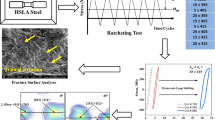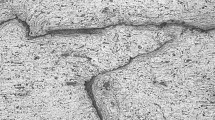Abstract
In this work, the crack growth behaviours of high strength low alloy (HSLA) steel E690 with three crystallographic orientations (the rolling direction, normal direction, and transverse direction) were investigated and compared from the view of the mechano-electrochemical effect at the crack tip. The results show that the crack growth of the HSLA steel is controlled by the corrosion fracture at the crack tip. The variation of crystallographic orientation in E690 steel plate has no influence on the crack tip electrochemical reaction and crack growth mechanism, but changes the crack growth rate. When the stress loading direction is parallel to the rolling direction and the fracture layer is parallel to the transverse-normal plane, the crack growth rate is the slowest with a value of 0.0185 mm·h−1. When the load direction and the fracture layer are parallel to the normal direction and the rolling-transverse plane, respectively, the crack growth rate is the highest with a value of 0.0309 mm·h−1. This phenomenon is ascribed to the different microstructural and mechanical properties in the rolling direction, normal direction, and transverse direction of E690 steel plate.
Similar content being viewed by others
References
X.G. Li, D.W. Zhang, Z.Y. Liu, Z. Li, C.W. Du, and C.F. Dong, Materials science: Share corrosion data, Nature, 527(2015), No. 7579, p. 441.
J.W. Zhao, Z.Y. Jiang, and C.S. Lee, Effects of tungsten on the hydrogen embrittlement behaviour of microalloyed steels, Corros. Sci., 82(2014), p. 380.
T.L. Zhao, Z.Y. Liu, X.X. Xu, Y. Li, C.W. Du, and X.B. Liu, Interaction between hydrogen and cyclic stress and its role in fatigue damage mechanism, Corros. Sci., 157(2019), p. 146.
E.D. Fan, S.Q. Zhang, D.H. Xie, Q.Y. Zhao, X.G. Li, and Y.H. Huang, Effect of nanosized NbC precipitates on hydrogen-induced cracking of high-strength low-alloy steel, Int. J. Miner. Metall. Mater., 28(2021), No. 2, p. 249.
T. Shoji, Z.P. Lu, and H. Murakami, Formulating stress corrosion cracking growth rates by combination of crack tip mechanics and crack tip oxidation kinetics, Corros. Sci., 52(2010), No. 3, p. 769.
S.M. Ohr, An electron microscope study of crack tip deformation and its impact on the dislocation theory of fracture, Mater. Sci. Eng., 72(1985), No. 1, p. 1.
Y. Li, Z.Y. Liu, E.D. Fan, Z.Y. Cui, and J.B. Zhao, The effect of crack tip environment on crack growth behaviour of a low alloy steel at cathodic potentials in artificial seawater, J. Mater. Sci. Technol., 54(2020), p. 119.
Y. Li, Z.Y. Liu, W. Wu, X.G. Li, and J.B. Zhao, Crack growth behaviour of E690 steel in artificial seawater with various pH values, Corros. Sci., 164(2020), art. No. 108336.
X. Chen, X.G. Li, C.W. du, and Y.F. Cheng, Effect of cathodic protection on corrosion of pipeline steel under disbonded coating, Corros. Sci., 51(2009), No. 9, p. 2242.
A. Turnbull and L. Wright, Modelling the electrochemical crack size effect on stress corrosion crack growth rate, Corros. Sci., 126(2017), p. 69.
A. Turnbull, M.S.D.S. Maria, and N.D. Thomas, Steady-state electrochemical kinetics of structural steel in simulated fatigue crack-tip environments, Corros. Sci., 28(1988), No. 10, p. 1029.
R.C. Newman, Stress-corrosion cracking mechanisms, [in] P. Marcus, ed., Corrosion Mechanisms in Theory and Practice, CRC Press, 2011, p. 511.
K.R. Cooper and R.G. Kelly, Crack tip chemistry and electrochemistry of environmental cracks in AA 7050, Corros. Sci., 49(2007), No. 6, p. 2636.
H.B. Xue and Y.F. Cheng, Photo-electrochemical studies of the local dissolution of a hydrogen-charged X80 steel at crack-tip in a near-neutral pH solution, Electrochim. Acta, 55(2010), No. 20, p. 5670.
M.M. Hall Jr, Interacting sensitivities of alloy 600 PWSCC to stress intensity factor, yield stress, temperature, carbon concentration, and crack growth orientation alloy 600, Corros. Sci., 125(2017), p. 152.
M.M. Hall Jr, An alternative to the Shoji crack tip strain rate equation, Corros. Sci., 50(2008), No. 10, p. 2902.
A. Turnbull, D.H. Ferriss, and H. Anzai, Modelling of the hydrogen distribution at a crack tip, Mater. Sci. Eng. A, 206(1996), No. 1, p. 1.
H. Krawiec, V. Vignal, E. Schwarzenboeck, and J. Banas, Role of plastic deformation and microstructure in the micro-electrochemical behaviour of Ti-6Al-4V in sodium chloride solution, Electrochim. Acta, 104(2013), p. 400.
J. Venezuela, Q.J. Zhou, Q.L. Liu, M.X. Zhang, and A. Atrens, Influence of hydrogen on the mechanical and fracture properties of some martensitic advanced high strength steels in simulated service conditions, Corros. Sci., 111(2016), p. 602.
Z.Y. Liu, C.W. Du, X. Zhang, F.M. Wang, and X.G. Li, Effect of pH value on stress corrosion cracking of X70 pipeline steel in acidic soil environment, Acta Metall. Sinca Engl. Lett., 26(2013), No. 4, p. 489.
Y.B. Hu, C.F. Dong, M. Sun, K. Xiao, P. Zhong, and X.G. Li, Effects of solution pH and Cl− on electrochemical behaviour of an Aermet100 ultra-high strength steel in acidic environments, Corros. Sci., 53(2011), No. 12, p. 4159.
Z.Y. Liu, X.G. Li, and Y.F. Cheng, Mechanistic aspect of near-neutral pH stress corrosion cracking of pipelines under cathodic polarization, Corros. Sci., 55(2012), p. 54.
Z.Y. Liu, X.G. Li, C.W. du, L. Lu, Y.R. Zhang, and Y.F. Cheng, Effect of inclusions on initiation of stress corrosion cracks in X70 pipeline steel in an acidic soil environment, Corros. Sci., 51(2009), No. 4, p. 895.
Y. Li, Z.Y. Liu, E.D. Fan, Y.H. Huang, Y. Fan, and B.J. Zhao, Effect of cathodic potential on stress corrosion cracking behavior of different heat-affected zone microstructures of E690 steel in artificial seawater, J. Mater. Sci. Technol., 64(2021), p. 141.
S. Tanhaei, K. Gheisari, and S.R.A. Zaree, Effect of cold rolling on the microstructural, magnetic, mechanical, and corrosion properties of AISI 316L austenitic stainless steel, Int. J. Miner. Metall. Mater., 25(2018), No. 6, p. 630.
H.C. Ma, J.B. Zhao, Y. Fan, Y.H. Huang, Z.Y. Liu, C.W. Du, and X.G. Li, Comparative study on corrosion fatigue behaviour of high strength low alloy steel and simulated HAZ microstructures in a simulated marine atmosphere, Int. J. Fatigue, 137(2020), art. No. 105666.
P.J. Wang, L.W. Ma, X.Q. Cheng, and X.G. Li, Influence of grain refinement on the corrosion behavior of metallic materials: A review, Int. J. Miner. Metall. Mater., 28(2021), No. 7, p. 1112.
H.Y. Tian, X. Wang, Z.Y. Cui, Q.K. Lu, L.W. Wang, L. Lei, Y. Li, and D.W. Zhang, Electrochemical corrosion, hydrogen permeation and stress corrosion cracking behavior of E690 steel in thiosulfate-containing artificial seawater, Corros. Sci., 144(2018), p. 145.
W. Wu, Z.Y. Liu, X.G. Li, C.W. Du, and Z.Y. Cui, Influence of different heat-affected zone microstructures on the stress corrosion behavior and mechanism of high-strength low-alloy steel in a sulfurated marine atmosphere, Mater. Sci. Eng. A, 759(2019), p. 124.
American Society for Testing and Materials, ASTM E647: Standard Test Method for Measurement of Fatigue Crack Growth Rates, ASTM International, West Conshohocken, 2010.
M.M. Hall Jr, Crack tip strain rate equation with applications to crack tip embrittlement and active path dissolution models of stress corrosion cracking, Environment-Induced Cracking Mater., [in] S.A. Shipilov, R.H. Jones, J.M. Olive, and R.B. Rebak eds., Environment-Induced Cracking Mater., Vol. 1, Elsevier, 2008, p. 59.
S.Q. Zhang, J.F. Wan, Q.Y. Zhao, J. Liu, F. Huang, Y.H. Huang, and X.G. Li, Dual role of nanosized NbC precipitates in hydrogen embrittlement susceptibility of lath martensitic steel, Corros. Sci., 164(2020), art. No. 108345.
K.R. Cooper and R.G. Kelly, Using capillary electrophoresis to study the chemical conditions within cracks in aluminum alloys, J. Chromatogr. A, 850(1999), No. 1–2, p. 381.
F.P. Ford, Quantitative prediction of environmentally assisted cracking, Corrosion, 52(1996), No. 5, p. 375.
B.G. Ateya and H.W. Pickering, The distribution of anodic and cathodic reaction sites during environmentally assisted cracking, Corros. Sci., 37(1995), No. 9, p. 1443.
A. Turnbull, Modelling of crack chemistry in sensitized stainless steel in boiling water reactor environments, Corros. Sci., 39(1997), No. 4, p. 789.
T. Shoji, Z.P. Lu, H. Xue, K. Yoshimoto, M. Itow, J. Kuniya, and K. Watanabe, Quantification of the effects of crack tip plasticity on environmentally-assisted crack growth rates in LWR environments, [in] S.A. Shipilov, R.H. Jones, J.M. Olive, and R.B. Rebak eds., Environment-Induced Cracking Mater., Vol. 1, Elsevier, 2008, p. 107.
L.J. Qiao, J.L. Luo, and X. Mao, Hydrogen evolution and enrichment around stress corrosion crack tips of pipeline steels in dilute bicarbonate solution, Corrosion, 54(1998), No. 2, p. 115.
R.N. Parkins, Predictive approaches to stress corrosion cracking failure, Corros. Sci., 20(1980), No. 2, p. 147.
R.N. Parkins, 1990 plenary lecture: Strain rate effects in stress corrosion cracking, Corrosion, 46(1990), No. 3, p. 178.
Z.Y. Liu, L. Lu, Y.Z. Huang, C.W. Du, and X.G. Li, Mechanistic aspect of non-steady electrochemical characteristic during stress corrosion cracking of an X70 pipeline steel in simulated underground water, Corrosion, 70(2014), No. 7, p. 678.
Z.Y. Liu, X.Z. Wang, C.W. du, J.K. Li, and X.G. Li, Effect of hydrogen-induced plasticity on the stress corrosion cracking of X70 pipeline steel in simulated soil environments, Mater. Sci. Eng. A, 658(2016), p. 348.
A.R. Troiano, The role of hydrogen and other interstitials in the mechanical behavior of metals, Metall. Microstruct. Anal., 5(2016), No. 6, p. 557.
R.A. Oriani, A mechanistic theory of hydrogen embrittlement of steels, Ber. Bunsen Ges. Phys. Chem., 76(1972), No. 8, p. 848.
H.Y. Tian, J.C. Xin, Y. Li, X. Wang, and Z.Y. Cui, Combined effect of cathodic potential and sulfur species on calcareous deposition, hydrogen permeation, and hydrogen embrittlement of a low carbon bainite steel in artificial seawater, Corros. Sci., 158(2019), art. No. 108089.
C.A. Zapffe and C.E. Sims, Hydrogen embrittlement, internal stress and defects in steel, Trans. AIME, 145(1941), p. 225.
W.Y. Choo and J.Y. Lee, Thermal analysis of trapped hydrogen in pure iron, Metall. Trans. A, 13(1982), No. 1, p. 135.
Z.Y. Cui, Z.Y. Liu, L.W. Wang, X.G. Li, C.W. Du, and X. Wang, Effect of plastic deformation on the electrochemical and stress corrosion cracking behavior of X70 steel in near-neutral pH environment, Mater. Sci. Eng. A, 677(2016), p. 259.
H.C. Ma, L.H. Chen, J.B. Zhao, Y.H. Huang, and X.G. Li, Effect of prior austenite grain boundaries on corrosion fatigue behaviors of E690 high strength low alloy steel in simulated marine atmosphere, Mater. Sci. Eng. A, 773(2020), art. No. 138884.
M. Koyama, C.C. Tasan, E. Akiyama, K. Tsuzaki, and D. Raabe, Hydrogen-assisted decohesion and localized plasticity in dual-phase steel, Acta Mater., 70(2014), p. 174.
A. Nagao, M. Dadfarnia, B.P. Somerday, P. Sofronis, and R.O. Ritchie, Hydrogen-enhanced-plasticity mediated decohesion for hydrogen-induced intergranular and “quasi-cleavage” fracture of lath martensitic steels, J. Mech. Phys. Solids, 112(2018), p. 403.
Acknowledgements
This study was financially supported by the China Postdoctoral Science Foundation (No. 2021M693706), Independent research project of State Key Laboratory of Mechanical Transmission of China (No. SKLMT-ZZKT-2021M10) and the National Environmental Corrosion Platform of China (No. NECP).
Author information
Authors and Affiliations
Corresponding author
Additional information
Conflict of Interest
The authors declare no conflict of interests.
Rights and permissions
About this article
Cite this article
Fan, E., Li, Y., You, Y. et al. Effect of crystallographic orientation on crack growth behaviour of HSLA steel. Int J Miner Metall Mater 29, 1532–1542 (2022). https://doi.org/10.1007/s12613-022-2415-6
Received:
Revised:
Accepted:
Published:
Issue Date:
DOI: https://doi.org/10.1007/s12613-022-2415-6




